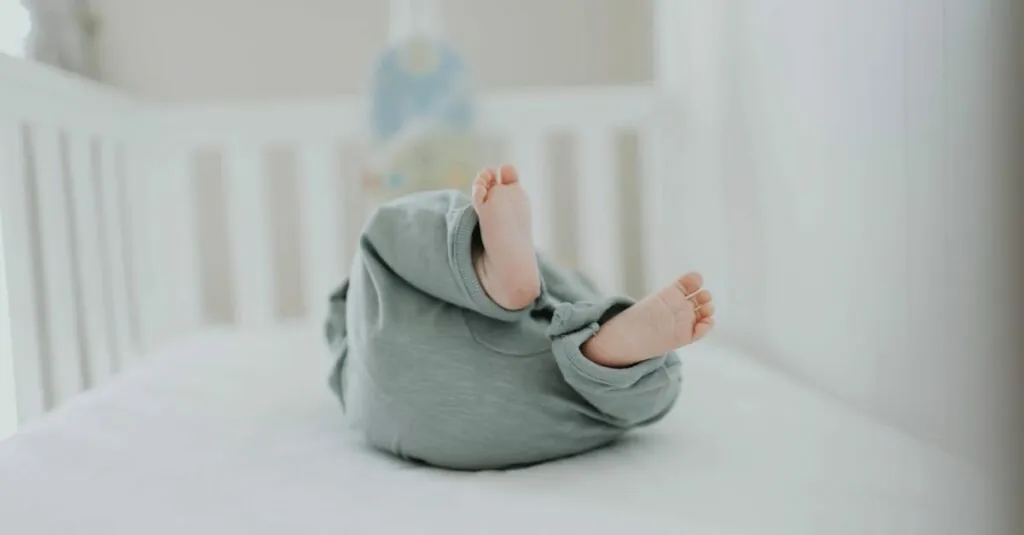Table of Contents
ToggleWhen it comes to dressing a newborn, parents often find themselves in a fashion conundrum. One question that frequently pops up is whether those tiny feet should be adorned with socks. After all, who doesn’t love the sight of those little toes peeking out from a cozy pair? But is it really necessary, or is it just another parenting dilemma designed to keep them up at night?
Newborns may not be strutting their stuff on the runway just yet, but keeping their feet warm is no laughing matter. As their little bodies adjust to the world outside the womb, the right clothing choices can make all the difference. So, should those precious feet be bundled up in socks or left to wiggle freely? Let’s dive into the sock debate and discover the answer that’ll keep both parents and babies happy.
The Importance of Keeping Newborns Comfortable
Newborns require comfort to thrive in their new environment. Maintaining a consistent temperature is crucial during the early weeks, as their bodies lack the ability to regulate heat effectively. Cold feet can contribute to discomfort and disrupt their sleep patterns.
Socks offer a layer of warmth, ensuring that the baby’s feet remain cozy. Infants often lose heat through their extremities, making socks an essential clothing item in cooler conditions. Soft materials help prevent irritation and provide a soothing feeling against sensitive skin.
Monitoring the room temperature also plays a significant role in keeping newborns comfortable. Recommendations suggest maintaining a room temperature between 68°F and 72°F (20°C to 22°C). Adjustments to clothing, including the use of socks, can help manage their body temperature effectively.
While some parents may worry about the necessity of socks, studies indicate that warmth contributes directly to better sleep. Babies sleep more soundly when they feel snug and secure. Ensuring proper coverage of their feet becomes a simple yet effective way to enhance their overall comfort.
The choice of socks matters too. Lightweight, breathable materials, like cotton, allow for airflow while still providing warmth. Choosing the right size prevents socks from slipping off, which can lead to worries about losing them during the night.
Comfort directly affects a newborn’s mood and behavior. A baby that feels warm and snug is generally calmer and engages more during awake periods. Prioritizing comfort through adequate clothing, including socks, establishes a harmonious environment for well-being.
Factors to Consider for Newborns Wearing Socks
Several factors influence the decision to dress newborns in socks. Parents must evaluate body temperature regulation and skin sensitivity.
Body Temperature Regulation
Newborns can’t effectively regulate their body temperature, making clothing choices vital. Socks help maintain warmth for tiny feet during cooler conditions. Cold extremities can lead to discomfort, which may disrupt a baby’s sleep. As newborns acclimate to their surroundings, parents should aim for a consistent temperature. Using socks can ease temperature management, especially during nighttime. A room temperature of 68°F to 72°F (20°C to 22°C) supports proper warmth. Adjusting layers, including socks, ensures that infants remain comfortable and sleep soundly.
Skin Sensitivity
Newborn skin requires gentle care, as it’s delicate and prone to irritation. Choosing socks made from soft, breathable materials like cotton minimizes the risk of rashes. Socks should fit properly to prevent slipping, which can cause discomfort. Skin contact with harsh fabrics may lead to irritation, making comfort paramount. Parents should look for socks designed specifically for infants, ensuring they meet the softness and fit requirements. By prioritizing gentle materials, parents can effectively protect their baby’s sensitive skin.
Benefits of Socks for Newborns
Socks offer several important benefits for newborns, primarily focusing on warmth and protection.
Keeping Feet Warm
Socks play a crucial role in keeping a newborn’s feet warm. Newborns’ bodies struggle to maintain a stable temperature, making warmth essential for comfort. Cold feet can lead to restlessness and interruptions in sleep. Lightweight socks made from breathable materials like cotton facilitate airflow while providing sufficient insulation. Parents notice that their babies sleep better when their feet are cozy. Choosing the right size ensures that the socks stay securely in place, which minimizes the risk of them slipping off during the night.
Protection from Environmental Factors
Socks protect newborns’ delicate skin from various environmental elements. Cold air and drafts can cause discomfort, especially in cooler temperatures. Properly fitted socks shield tiny feet from these conditions. Additionally, socks prevent exposure to rough surfaces that may irritate sensitive skin. During outings, socks add a layer of warmth when placed in carriers or strollers. Parents can relax knowing that their babies are comfortable and safeguarded from climate fluctuations. Prioritizing the right materials and fit can enhance the overall comfort and well-being of newborns.
Potential Drawbacks of Wearing Socks
Parents often weigh the drawbacks of dressing their newborns in socks. While socks can provide warmth, certain concerns exist.
Risk of Overheating
Overheating poses a significant risk when newborns wear socks. Babies’ bodies have difficulty regulating temperature. Excessive layers can trap heat, leading to discomfort or sleep disturbances. According to pediatric guidelines, maintaining a stable temperature between 68°F and 72°F is crucial. Socks, if too thick or made from non-breathable materials, can hinder this temperature management. Monitoring the baby’s overall warmth becomes critical, as signs of overheating include excessive sweating or flushed skin. Parents often need to balance the desire for warmth with the potential for overheating.
Difficulty in Monitoring Foot Health
Wearing socks complicates the ability to monitor foot health in newborns. Parents typically assess their baby’s feet for signs of abnormalities or irritation. Socks can conceal crucial indicators like rashes or blisters, which may require immediate attention. When the socks fit snugly, discomfort may arise without visible signs. Regularly checking the condition of their feet can help avoid issues, but socks can create an obstacle. Parents might find it essential to remove socks periodically to ensure that the baby’s feet remain healthy and free from irritation.
Deciding whether newborns should wear socks ultimately hinges on balancing warmth and comfort with potential risks. Socks can be a valuable addition in cooler environments helping to keep tiny feet warm and cozy. However parents must stay vigilant about monitoring their baby’s temperature to prevent overheating.
Choosing the right materials and ensuring a proper fit are crucial steps in making this decision. By prioritizing softness and breathability parents can enhance their newborn’s comfort while safeguarding their delicate skin. Regularly checking their baby’s feet will also help maintain foot health. With thoughtful consideration parents can create a nurturing environment that supports their newborn’s well-being.




